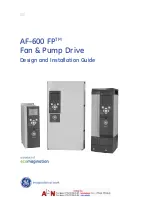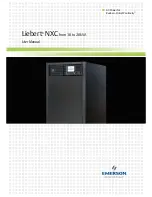
MV3DB Series DB Units
7. Diagnostics
(07/06)
ALSPA MV3000e Dynamic Braking Units
Page 7-1
7. Diagnostics
7.1 Fault
monitoring
The drive continuously monitors the performance of the DB Unit and braking resistor.
A malfunction of the dynamic brake will result in the drive indicating a warning or a trip,
depending on the nature of the fault.
To aid fault diagnosis the drive keeps a log of warnings and trips, which are entered as
warning or trip fault codes. Use of the log is explained in Section 6 of the Getting Started
Manual, which also shows how to view the fault codes and what action to take in the event of a
warning or trip. This section also explains how to reset a trip.
7.2 Warnings
The drive illuminates the WARNING indicator if a fault occurs which is not sufficiently serious
to trip the drive. Warnings are not latched, so that if the reason for the warning is cleared the
WARNING indicator will extinguish, though a record may be maintained in the History Log to
aid possible further diagnosis (if configured by the user).
The warning fault code and possible diagnosis is given in Table 7-1.
Table 7-1 Warning diagnosis
Warning
Code
Description Possible
Fault
104
DB resistor.
There is <25%
power dissipation capability
remaining.
If this warning occurs often:
1.
Use a higher rated braking resistor.
2.
Power data may be incorrect. Review calculations in
Section 3.
7.3 Trips
The drive flashes the TRIPPED indicator if a serious fault has caused it to trip. Trips are
latched and the drive cannot be used until the fault is cleared and the drive is reset as
described in the Getting Started Manual.
A list of trip fault codes and possible diagnosis is given in Table 7-2.
Table 7-2 Trip diagnosis
Trip Code
Description
Possible Fault
3
DC overvolts.
The DC Link
voltage has exceeded the
maximum permitted value
when the load is decelerating.
1.
DB Unit not enabled. Check status of CF110 (P23.08).
2.
Peak braking power capability of DB Unit/resistor is
insufficient for the application.
3.
Braking resistor open circuit.
4.
Loose termination or break in wiring to resistor.
5.
Malfunction of DB Unit.
6
Overtemperature.
Drive or
DB Unit temperature has
exceeded its maximum safe
level.
1.
Excessive use of dynamic brake.
2.
Possible obstruction of airflow through drive.
3.
Ambient temperature too high.
67
DB resistor trip.
The drive
estimates (from data) that the
braking resistor is too hot.
1.
Application requires more braking effort than the
resistor can absorb. Use a higher rated resistor.
2.
Incorrect data entered for the braking resistor in use.
(continued)









































